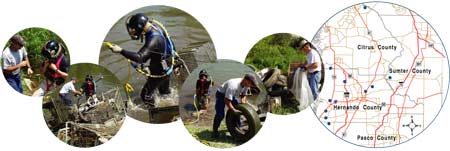
Kass Sink looked harmless enough from the edge, but just below the surface, piles of garbage and debris sat potentially poisoning the drinking water.
Kass Sink is like many other sinkholes in Hernando and Citrus counties. Most are clustered around or are considered a part of one of the five first-magnitude springs systems: Weeki Wachee, Homosassa, Chassahowitzka, Kings Bay and Rainbow springs. Some of the sinks have a direct connection to the aquifer. While others may no longer have a direct connection, these sinks serve as recharge areas where water filters through the sand and other organic material to the aquifer. Therefore, garbage illegally dumped in these sinkholes can still pose a health risk to humans.
In an effort to improve water quality, the District has identified 11 sinkholes to survey and clean up. Some of the sinkholes are on county land and some are on private property. Staff worked with the owners to get approval to do the work.
The District’s Governing Board has budgeted $100,000 in fiscal year (FY) 2005 and an additional $100,000 in FY2006 for this project, which includes removing the debris from below the waterline then properly disposing of it. The operation is part of the Springs Cleanup Initiative.
The District hired Dive-Tech International, Inc. to survey each site and to remove the debris from below the waterline.
“Because we didn’t know what to expect with this project, we had to approach it differently than most projects,” said Chris Zajac, project manager and environmental scientist.
Most projects have specific goals or physical work to be finished. In this case, the District wouldn’t know what was necessary until after a survey was completed.
A diver in the water would stir up too much silt and reduce visibility, so Dive-Tech used a robotic camera to survey each site.
During the removal process, the team used the survey as a guide to determine what to expect and where. One diver remained onshore monitoring the other diver’s air supply hose. The team’s project manager also remained onshore to communicate by radio with the diver in the water.
Kass Sink is in Spring Hill and was the first site to have a major amount of debris removed.
“During one of the surveys, the divers only found a small amount of garbage at one of the sites, so they removed it at that time,” said Zajac. “Some of the other sites are so loaded that the dive team has to dedicate a week to diving and removing debris.”
Divers pulled several trailers’ worth of debris from Kass Sink. The trash heap pulled from the sink included everything from rusty shopping carts, mattresses and beer cans to microwaves, roofing tar buckets, empty paint cans and a can of carburetor cleaner, a computer monitor (which includes batteries and toxic metals) and even a bowling ball! The District’s Operations Department loaded it all into several trailers and hauled it away to be properly disposed of at the county dump.
The District hauled away nearly three tons of garbage from Kass Sink and at least three other locations during the month of June.
In an effort to prevent future illegal dumping, the District is working with local governments and private land owners to reduce dumping into sinkholes.
Other sites on the list to be cleaned out include: Blue Sink/Hernando, Blue Sink/Citrus, Chassahowitzka Sink, Heather Sink, Arch Sink, Canyon Swallow, Forest Oaks Sink, Brayko Sink and Winter Sink.
